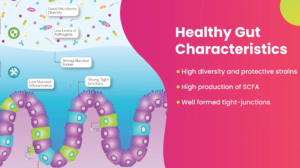Understanding leaky gut and the microbiome can be complicated, however, I want to break it down so you can understand why it is so important to have a healthy microbiome and why probiotics help, and I shouldn’t just say help but are actually the key to the health of the intestinal lining of our GI tract. Our microbiome is “held” inside our gut lining full of good bugs and
 some bad bugs. There needs to need a 70/30 ratio or even 80/20 ratio of good vs. bad bugs so they keep each other in check. When that ratio becomes 50/50 or less than we start to get into trouble, and those bad bugs can start to perforate tiny “holes” in the intestinal walls making them leaky to the rest of the body. This is where, undigested food particles, drugs, endotoxins, LPS, pathogens get into the blood stream and wreck havoc on the body. How do we keep this balance in check? How do we keep more good bugs alive and bad bugs to a minimum. And have you wondered…How do these bad bugs become more populated than the good guys?
some bad bugs. There needs to need a 70/30 ratio or even 80/20 ratio of good vs. bad bugs so they keep each other in check. When that ratio becomes 50/50 or less than we start to get into trouble, and those bad bugs can start to perforate tiny “holes” in the intestinal walls making them leaky to the rest of the body. This is where, undigested food particles, drugs, endotoxins, LPS, pathogens get into the blood stream and wreck havoc on the body. How do we keep this balance in check? How do we keep more good bugs alive and bad bugs to a minimum. And have you wondered…How do these bad bugs become more populated than the good guys?
What we eat determines this, what we put in our bodies and on our skin. Our microbiome is built up of the good guys, bad guys, bacteria, fungi, protozoa, viruses, LPS, (a gram negative bacteria called lipopolysaccharides) Which we also have all over our bodies, but mainly lives in our GI tract. These guys (LPS) I will come back to, but mainly they live in our gut, however, it’s when they slip through those junctions that became “leaky” and into the blood stream is where the damage begins. Many believe these are the culprits for most of the inflammation in the body especially the brain, they can move fast in the body creating so much destruction. The more LPS in circulation, the more severe the amount of inflammation one has.
What and how does the gut become leaky? I described above that too much bad bacteria compared to the good ones can disrupt the ratio and the bad guys can start proliferating and literally do the damage to the intestinal walls causing them to lose there tight junctions in-between the cells and let things leak through, especially the LPS which then creates damage throughout the body. There are a few other factors to consider, and of course that is the food we eat. The more destructive food we eat, the more damage to the lining of the walls, and can also feed the bad bacteria, starving off the good guys. The good guys need veggies, roots, fiber, and a lot of it to survive. But the main thing I want to talk about is stress.
Stress is the number one driving factor of leaky gut, along with a poor diet, which usually come hand and hand. Stress disrupts the HPA (pituitary) axis in our bodies and the more stress the more turned on it can get. The major problem is when stress turns chronic and the body literally can’t turn it off. Have you ever felt so stressed, that literally you can’t deal with one more thing, and everything in life seems too huge, you can’t concentrate, you even can get jumpy, heart races, anxiety panic and you start losing sleep. Stress is everywhere in our lives, it’s normal, it’s also sometimes good to keep us going, but we need the HPA axis to step in and turn off the stress response once the stress is over. Most of us, when the stress is over, the body can’t turn off due an unhealthy microbiome. The check point is our gut. Cortisol gets released when we have a stress response, (did you know cortisol also gets released every time we eat sugar.) This release excites the immune system, (This is also why you can’t eat while you are stressed because digestion will stop) The immune releases cytokines and chemokines for inflammation to help the stressor. These cytokines can go to brain and flood the brain with blood which increases inflammation, but also heightens you to prepare you for the stressor. Cortisol then starts a negative feedback loop will bind to glucocorticoid and bring your heightened state back down. However, this depends on whats going on in the gut, if we are in that pro-inflammatory state in the gut it drives the HPA axis again with more release of cortisol which accumulates in the system and not enough glucocorticoid to bring the system back down and this hyperactive and over-sensitive state begins. This loop would work if the microbiome was in a healthy state.
The good guys, what do they do, and why are they beneficial to our bodies? I should say what don’t they do? They literally help almost every part of us to survive and keep us out of inflammation. Digestion, sleep, brain health, break down food, make vitamins, heal immune system and aid in the immune system, fight off bacteria, control inflammation, produce enzymes that enable us to break down food. We don’t want to damage them by drinking chlorine in our water system, or worse any other chemicals, why a purification system is so important. Of course, circling back to the food we eat, destructive food like, fried, packaged, chemical ridden, full of preservatives, poor quality oils, caffeine, sugar will only feed the bad guys and starve the good guys. Also toxins on our air, this is a huge part that many don’t even think of. The really big key and interesting thing to really understand, is our organisms literally read our neurotransmitters. The more opportunistic (bad) bacteria we have the higher virulence factors we have, which will down regulate neurotransmitters like serotonin, melatonin, norepinephrine, epinephrine, leading to increased anxiety and depression. Sleep is about housecleaning and when we don’t get the adequate amount of sleep, we can’t function or heal. When the microbiome is unhealthy with too many bad bugs which change the amount of hormones and neurotransmitters that are also needed for sleep, causing the inability to ward off the stress in the first place.
How do we get out of these loops/cycles and maintain a healthy microbiome? Well, most importantly we need to find daily practices of stress reducing activities and mindful practices of slowing down, this is first and most essential, because “no pill” can undo your environment. Secondly, change your food habits. It’s that simple, starve the bad guys now and get your good guys to thrive! Third is probiotics. You can find foods that are prebiotic (foods that feed the good guys) like fermented foods, yogurts (unsweetened) kefir, veggies with skins, herbs, however we most likely don’t eat these that often/enough or in good sources. So we need to put these guys back in us. This happens in 2 ways, there are native probiotics and transient probiotics. Basically without getting too detailed, transient ones are the ones you see in health foods stores, these are the probiotic strains (usually see around 12-15 on the bottle of the more popular ones) and we literally give ourselves these strains. The native ones are spore based form. These help populate what you already have, making better communities of your own microbes to set up shop in your gut. These help strengthen your microbiome more become robust. When I work with clients I usually have people go on 3 months of spore based probiotics and then after switch every month back and forth from transient ones back to spore based to keep the population and diversity healthy, along with eating clean, full of prebiotics. The difference is astounding, stress lessens and more manageable, sleep is restored, mood aligns, inflammation subsides, we become healthy, the body starts to thrive and starts to clean up other damages in the body once the microbiome is now helping with digestion, strengthening the immune, making enzymes and so on.
Healing leaking gut, along with adding probiotics, while cleaning up your eating habits all needs to happen, one thing can’t do it all. Heres a look at a healthy microbiome with thanks to microbiome labs for their picture below.




